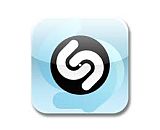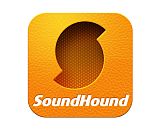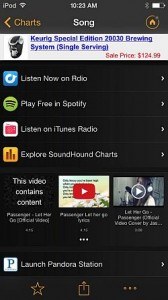
 With app downloads numbering hundreds of millions, Shazam and SoundHound have proven that music identification is a service in demand. With either app running, pointing your phone at any music source (radio, TV, dance club, bar) identifies a song in seconds. The apps are meant to be used in the real world, and judging by app review comments they are frequently used to identify songs on the radio.
With app downloads numbering hundreds of millions, Shazam and SoundHound have proven that music identification is a service in demand. With either app running, pointing your phone at any music source (radio, TV, dance club, bar) identifies a song in seconds. The apps are meant to be used in the real world, and judging by app review comments they are frequently used to identify songs on the radio.
In an online music service, you get things started by saying, “I choose that.” Shazam and SoundHound answer the question: “What is that?”, often asked when listening to radio.
That’s powerful, but just the start of how influential these gateways can be.
On-ramps to music streaming
Song identification is only half the consumption cycle. Shazam and SoundHound were founded on the idea of real-world music recognition, but recently have increasingly added features that close the circle back into listening services. They act as on-ramps to streaming music. As such, these apps can be a siphoning threat to radio, insofar as a user is encouraged to identify a song playing on the radio, then instantly migrate further listening, discovery, and ownership to Internet platforms.
 After identifying a song in either app, both Shazam and SoundHound can play a 30-second clip. And each app enables an easy toss to Rdio or Spotify to hear the whole thing. (A subscription account is sometimes required, depending on the device and the service.) SoundHound recently updated its iOS app with some fanfare, incorporating iTunes Radio. No subscription is needed in that ad-supported environment. Sending the artist/song into Pandora is also an option. In both those cases, an artist/song station is launched, and the user hears music related to the identified song.
After identifying a song in either app, both Shazam and SoundHound can play a 30-second clip. And each app enables an easy toss to Rdio or Spotify to hear the whole thing. (A subscription account is sometimes required, depending on the device and the service.) SoundHound recently updated its iOS app with some fanfare, incorporating iTunes Radio. No subscription is needed in that ad-supported environment. Sending the artist/song into Pandora is also an option. In both those cases, an artist/song station is launched, and the user hears music related to the identified song.
Shazam has the same approach, but with different options. iTunes Radio and Pandora are missing — advantage SoundHound. Shazam stays focused on the exact song which has been identified, seeming to reject the idea of launching an Internet station based on the song. (Though it won’t surprise us if Shazam attains parity with SoundHound by adding iRadio and Pandora). Shazam arguably offers more information, including artist concerts and tours, artist bios, and discography. [SoundHound pointed out to us that the SoundHound app also provides concert/tour info through a partnership with StubHub.]
Both services integrate YouTube. This is a compelling feature, aligned with YouTube’s status as the most popular listening platform in youthful demographics. The experience is expansive, insofar as YouTube presents content (like live performances) entirely missing from Spotify, Rdio, Pandora, and their ilk. The experience stays within the Shazam or SoundHound app, unlike the Spotify and Rdio throw-overs, which open those apps independently.
Both Shazam and SoundHound offer in-app music discovery via charts of top song identifications. Here too, when you find something, you’re encouraged to migrate your new musical interest to an Internet platform.
Putting radio into the mix
So Shazam and SoundHound act as gateways to online music services. That’s perfectly natural for mobile apps. But we have an idea which would insert radio listening into the picture: add the unique Radio Search Engine into the feature set. (See our Radio Search Engine review here.) Radio Search Engine conducts rapid, real-time searches of radio stations (and some Internet stations) playing a song, and streams the station webcast. In this scenario, Shazam and SoundHound, which exist partly to identify music played on the radio, can close the circle back into the FM realm.
